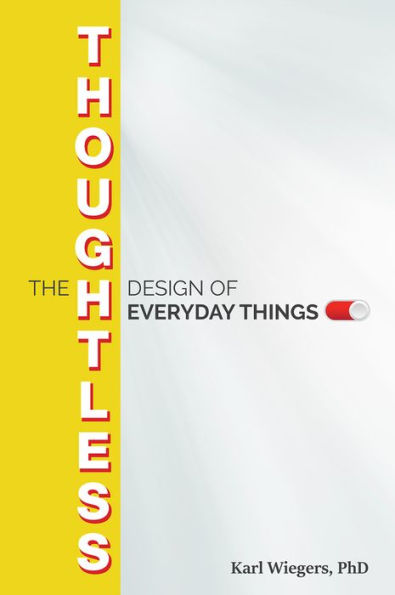

Paperback
-
PICK UP IN STORECheck Availability at Nearby Stores
Available within 2 business hours
Related collections and offers
Overview

Product Details
| ISBN-13: | 9781604271782 |
|---|---|
| Publisher: | Ross, J. Publishing, Incorporated |
| Publication date: | 02/16/2021 |
| Pages: | 320 |
| Product dimensions: | 6.00(w) x 9.00(h) x 0.70(d) |
About the Author
Table of Contents
Acknowledgments xiii
About the Author xv
WAV™ page xvii
Chapter 1 Thoughtless Design 1
Thoughtful and Thoughtless Design 1
About This Book 4
A Thoughtless Design Case Study: The Sponge Mop 5
The Crap Gap 7
Consumers and Their Requirements 8
Is It Really a Design Problem? 10
Some Terminology Conventions 11
A Key Assumption 12
Looking Ahead 14
Chapter 2 Why Design Is Hard 15
What Is Design? 15
Where Designs Come From 16
Three Critical Contributors to Design Success 19
Design Is a Balancing Act 22
Stakeholders 22
Design-For Attributes 24
Usability Design 27
The Profit Perspective 30
Some Symptoms of Thoughtless Design 31
During Prototype and Usability Evaluations 31
After Delivery 31
Chapter 3 Make the Product Easy and Obvious to Use 33
Signifiers 35
I Just Wanted to Take a Shower 38
Intuitive to Whom? 39
Thoughtful Design: Google Translate 43
No Surprises! 44
What Is It with Cars? 46
Two Laws of Computing 51
When All Else Fails, Read the Instructions 53
Be Accurate and Specific 55
Language Lessons 55
Size Matters 56
Thoughtful Design: Avocado Slicer 57
Chapter 4 Consider Realistic Usage Scenarios 59
Around the House 60
In the Bathroom 60
In the Kitchen 61
In the Closet 63
In the Wine Cellar 64
In Physical Therapy 65
Thoughtful Design: Japanese Garden Knife 66
Thoughtful Design: Vacuum Cleaner Floor Brush 67
A Twenty-Year Annoyance-and Counting 69
Software Silliness 70
Thoughtful Design: Contacts App 73
Hardware Problems, Too 74
Bad Actors and Dangerous Actions 77
Accident 78
Malice 78
Stupidity 79
Chapter 5 Consider a Wide Range of Usage Environments 83
Understand the User's World 84
One More Time with the Cars 86
Less Than Ideal Conditions 88
Computer Environments 90
Thoughtful Design: Night Modes on Portable Devices 92
Chapter 6 Make It Hard to Make a Mistake 93
To Err Is Way Too Human 94
Make Mistakes Impossible 96
With Software 96
With Physical Objects 98
Thoughtful Design: 3D Motion Model 101
Thoughtful Design: Garden Hose Sprayer 102
Make Mistakes Difficult 103
Make Recovery Easy 109
The Case of the Mysterious Error Message 109
The Case of the Forced Completion 110
The Case of the Inactive Function 113
Just Let It Happen 115
Of Course, Cars Again 115
In the Optometrist's Exam Room 119
Chapter 7 Provide Meaningful Feedback 121
Make Feedback Immediate 124
Make Feedback Informative 125
Make Feedback Necessary 126
Make Feedback Clear 127
Make Feedback Actionable 132
Make Feedback Persistent 137
Make Feedback Polite 139
Chapter 8 Don't Waste the User's Time 141
Hidden Options 141
Excessive Actions 145
You Can't Get There from Here 149
Excessive Complexity 149
I Just Want to Be Warmer 150
Has Anyone Seen the Remote? 151
Overwhelming Functionality 155
Obscure Operations 157
Things That Just Don't Work 159
Thoughtful Design: Time Savers 161
Chapter 9 Design for the User's Convenience 163
In the Bathroom 164
You Knew There Would Be Cars 165
On the Computer 168
Customization 168
Disappearing Functionality 169
Computers Should Work for Us 170
Inconvenience Is All Around Us 171
Voicemail 171
Musically Speaking 173
At the Supermarket 175
Digital Is Not Always Better 177
Packaging Fails 180
Thoughtful Design: For the User's Convenience 185
Deliberately Devious Design 190
Chapter 10 Accommodate the Range of Human Variation 195
The Breadth of Human Diversity 196
Accessibility 199
Ergonomics 202
Thoughtful Design for All 207
Chapter 11 Place the Minimum Mental Burden on the User 209
What Does This Mean? 209
Confusing Controls 211
Concealed Capabilities 214
Consistency Is a Virtue 215
It's Only Logical 222
Thoughtful Design: Home-Use EKG 226
Thoughtful Design: Restore iPhone from Backup 228
Wrapping Up 229
Chapter 12 Practices for Thoughtful Design 231
Customer Engagement 231
Product Champions 232
Focus Groups 234
Personas 235
Usage-Centered Design 237
Systems Thinking 239
Prototyping 241
Iterative Improvement 242
Tips for Successful Prototyping 244
Usability Testing 246
Reflection and Learning 248
Retrospectives 249
Customer Feedback 250
Keep the Focus on Usage 251
Your Turn Now 254
Appendix: Summary of Design Lessons 255
References 261
Index 267
